Subtleties of storing cereals and other bulk products
Any housewife should have an idea of how to store products, including non-perishable ones: rice and other cereals, pasta, flour, sugar, tea, etc. Temperature conditions, humidity levels, the selected container for bulk products - all this has meaning. After all, it is often improper storage that leads to food spoilage. And spoiled foods not only lose their taste, but also become hazardous to health.
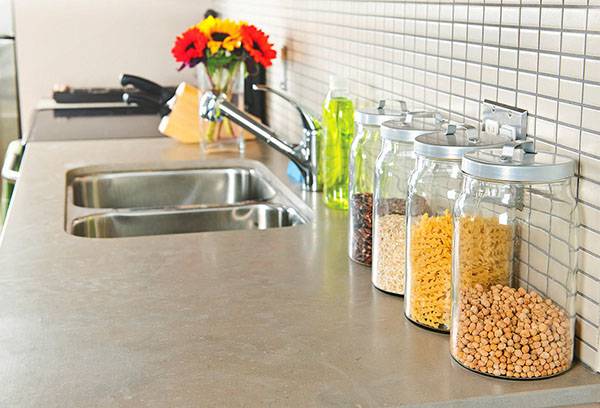
What are the dangers of improper food storage?
One of the enemies of bulk products, especially cereals, is mold, which usually develops due to high humidity in the kitchen. As it multiplies, it destroys food, resulting in an unpleasant odor and the formation of toxins. Eating food contaminated with mold is hazardous to your health.
Insects may also appear in bulk products. One of the common pests is the Suriname mucoed. This is a brown bug that grows in flour, different types of cereals, and dried fruits. Unlike microorganisms, insects do not destroy cereals, but contaminate them. But at high concentrations, pests or their metabolic products can lead to food poisoning.
Expired products, although visually they look normal, lose their taste and beneficial properties. Even if you know how to store cereals, it is important to remember that bulk products cannot be stored forever.If you prefer to buy for future use, first try to cook from products purchased a long time ago. And in order not to confuse anything, you can put stickers on the containers with the date the contents were placed.
Of the cereals, oatmeal spoils the fastest - in 4-6 months, and flakes with all kinds of additives are stored even less. Rice can be stored for about 1.5 years, peas and buckwheat - up to 2. Other cereals are best consumed within 9-12 months. Plain pasta will last about 1 year. It is recommended to store pasta with various additives, such as tomato, for no longer than 3-5 months.
Advice
Carry out an annual audit of the kitchen, during which you check the expiration dates of the contents of the cabinets and, if necessary, throw away anything spoiled.
Basic storage rules
To avoid problems with products in your kitchen, carefully examine them in the store. Damaged packaging, sticky grains, foreign inclusions among the grains - all this signals that the product is not worth buying. If it is not possible to evaluate the product visually, for example, if it is sold in an opaque bag or box, be guided by the production date and recommended shelf life.
Despite the fact that production measures are taken to prevent the contamination of cereals by insects, unpleasant exceptions do occur. Therefore, before putting the cereal away for storage, it is recommended to check it again for the presence of mold and larvae and pour it out of store containers. Some people prefer to leave rice and other grains in plastic bags. But this is not recommended: food in them can become damp, “suffocate” and acquire an unpleasant smell and taste.
It is better to store flour, rice, sugar and other products in closed jars and containers. Before putting anything into a jar for storage, it must be washed thoroughly with a cleaning agent and dried. For storing food in large volumes, a linen bag boiled in a saline solution is suitable. The matter allows the products to “breathe” and not get stale, and the salt barrier prevents insects from getting inside.
Bulk products should not be stored in direct sunlight. The best place for them is in the kitchen cabinet. It's dark, cool and dry - these are the best conditions for bulk products. Bags of sugar should not be placed directly on the floor. It is better to place them on some kind of tray away from sources of moisture and heat.
Useful tips
- During storage, the air humidity in the room should not exceed 65-70%, and the temperature should not exceed 19-20 degrees.
- For semolina, pearl barley, millet and oatmeal, cool storage is desirable. Otherwise, they may acquire a bitter taste. This is due to the fact that at temperatures above 16-18 degrees, vegetable fat can go rancid. If you cannot maintain this temperature, buy these cereals in small quantities.
- It is unacceptable to store cereals in basements, poorly ventilated and damp areas.
- Do not scoop sugar, flour or spices with a wet or damp spoon. A wet product can not only lose its quality, but also become moldy. For the same reason, you should not hold open containers with bulk products over a saucepan or frying pan when something is being cooked there.
- Do not store salt, sugar, flour, rice and other cereals in open packages next to foods that have a strong odor. Such products include spices, dried mushrooms and herbs.
- Also, cleaning agents and detergents containing odorous fragrances should not be placed near the storage area for bulk products.
- To preserve the taste of products and protect them from spoilage, try not to make bulk purchases unless absolutely necessary. It's better to renew your supplies as you use them.
What type of storage utensils should be used?
Glass, ceramic, plastic and other containers for storing cereals, sugar and tea can be found in stores in large quantities and at different prices. Many housewives choose a set of containers based on aesthetic preferences, as well as the design features of the kitchen. In order for bulk products to retain freshness and taste, in addition to appearance, it is worth considering a number of other indicators.
Flour, grains and legumes can harbor moths and bugs. Also in the kitchen, where food is constantly being prepared, there are foreign odors. You don't want your tea to smell like fried meat, do you? That is why the dishes must be airtight and the lid must be tight. In addition, in an airtight container, products are not afraid of high humidity. Lids with seals do an excellent job of this task. A good option is hinged lids with latches, which allow you to store food in both tightly closed and ventilated containers.
If you prefer to store food on open shelves, choose opaque containers that will not allow light to pass through. The material from which the dishes are made should not have any foreign odors. For example, containers made of low-quality plastic have a very unpleasant odor, which can transfer to food. It is worth considering that some materials absorb aromas well.This means that dishes made from such materials will retain the smell of the contents for a long time. For example, a wooden container after storing coffee in it can smell like this product for several years.
The size and shape of the container are equally important. A set of square or rectangular containers, as opposed to cylindrical ones, will take up less space, which will allow you to fit more products in one cabinet. If you want to make efficient use of space, choose containers whose height is as close as possible to the height of the shelf. If you have a large family in which food is used up very quickly, it is better to give preference to larger containers. For cereals that you rarely eat, small dishes are also suitable.
Worth knowing
Many people make a serious mistake: they take a grain, such as rice, on top of the container, then add a fresh portion, and then take the rice on top again. Thus, the cereal located at the bottom is not used at all. This can lead to product spoilage, as well as the appearance of moths and bugs. Do not forget that containers with bulk supplies should be completely emptied from time to time.
Review of container materials for bulk products
- Glass
Glass jars are considered ideal for storing non-perishable foods. Through the transparent walls you can clearly see what is stored in them. Glass containers are easy to clean and do not absorb foreign odors. The main disadvantage is that glass can easily break. Today there are dishes made from shock-resistant material on sale, but their cost is higher than usual. Products placed in transparent glass jars can only be stored in a dark place.
- Plastic
The choice of shapes, colors and sizes of plastic containers is quite extensive.They are low cost, lightweight and compact. But plastic containers are not recommended for storing seasonings. Many spices, when interacting with plastic, release toxic substances.
Over time, plastic may crack, become deformed when exposed to high temperatures, become cloudy, or turn yellow. Another disadvantage: some types of plastic have a persistent unpleasant odor. Before purchasing, be sure to smell the container: the faint odor will dissipate over time, but you should not buy containers with a strong chemical smell. And pay attention to the lid: not all plastic containers have a lid that fits tightly.
- Ceramics
Ceramic jars are not only convenient, but also very beautiful. They are opaque, but you can buy a set in which, based on the color and design, you can easily determine what is in each jar. Ceramic jars have no foreign odors and are easy to clean. You should not take containers where the lid just lies on the jar and does not fit tightly to it. It is better to give preference to jars equipped with silicone gaskets.
- Metal
Metal containers are light and durable, but not the most practical. These cans can impart a slight metallic taste to foods. In addition, high humidity in the kitchen can cause rust, which is not good for your health. If you still decide to give preference to metal containers, choose high-quality stainless steel containers that are not susceptible to corrosion.
- Tree
Wooden containers look very colorful and interesting, but they are not suitable for storing most products. They absorb moisture and odors, are not airtight, and are difficult to clean.In addition, such vessels are usually not equipped with airtight lids. Wooden containers are convenient for storing bay leaves, dried herbs and salt.
Advice
When buying a ceramic container, do not confuse it with melamine - a toxic and harmful material to humans. Despite the external resemblance to ceramics, such dishes are easy to distinguish: at the bottom of the melamine product there is a sign in the form of the letter “M”.
Features of spice storage
There are many natural aromatic additives - herbs, dried inflorescences, roots, etc. Seasonings cannot spoil or turn sour. But if stored improperly, they can lose their taste and aroma. In general, when storing spices, you must follow the same recommendations as when storing all other bulk products. But there are several nuances that are definitely worth considering.
First of all, it is necessary to consider the shelf life of spices. Seeds are stored for up to 3-4 months, herbs - 1-2 years, ground spices - no more than 1 year. The record holders for shelf life among spices are cinnamon, pepper and cloves. It is better to grind spices in inflorescences or pots immediately before adding them to a dish, since they lose their properties faster when ground.
Many people buy seasonings in bags, which, once opened, lose their seal. To preserve the taste and aroma, it is better to pour the seasoning into small ceramic or glass jars. Don't forget that spices don't like overheating, so they shouldn't be stored near a gas stove. Seasonings based on red pepper (paprika, chili) are best stored in the refrigerator. For other spices, refrigeration is not required.
Folk secrets for long-term storage
- To prevent insects from infesting the purchased cereal, place it in the freezer for 1-3 days directly in the packaging from the manufacturer. You can also heat the cereal in a frying pan, oven or microwave.
- Add red hot pepper to the rice. Pepper will not only protect the rice from insects, but also prevent the appearance of a musty smell.
- You can put a cloth bag of salt at the bottom of the container with cereal.
- You can also add an unpeeled garlic clove or a piece of dried lemon zest to the rice. Chestnut will also help protect cereals from the appearance of bugs and worms.
- Place a piece of twisted foil, a metal spoon, or a bay leaf into the flour.
- Very often, salt cakes in lumps. To avoid this, put rice in it (a few grains will be enough).
- Sugar can harbor ants. To prevent them from appearing, place a few dried orange or lemon peels in a bag of sugar.
- To prevent the appearance of bugs during general cleaning, wipe the kitchen cabinet with a vinegar solution. And to get rid of the smell of vinegar, place cotton pads soaked in lavender oil on the shelves.
- To keep kitchen cabinets dry, place bay leaves or glass cups with lime in the corners. You can also place several open containers with salt, which absorbs moisture and disinfects.
Compliance with all food storage conditions not only protects your supplies from spoilage, but also allows you to maintain cleanliness and order in the kitchen. If you do overlook something and it leads to mold or insects, get rid of these products without regret. You shouldn't skimp on your health.
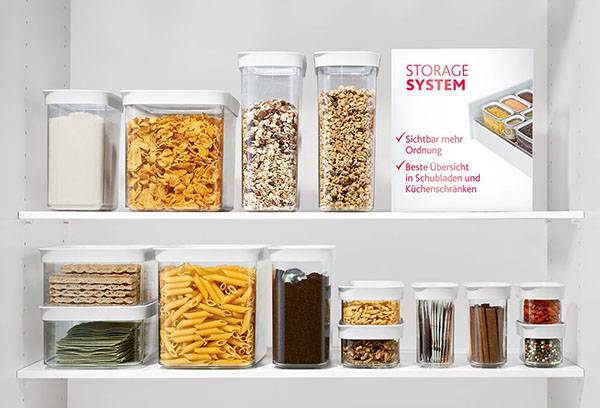
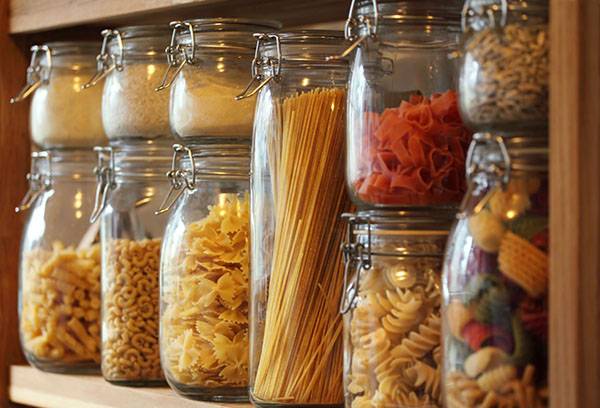
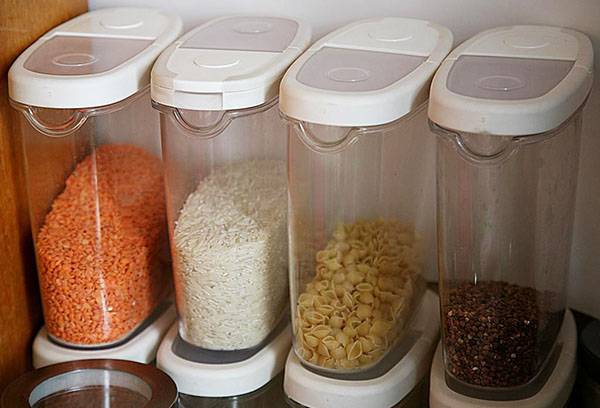
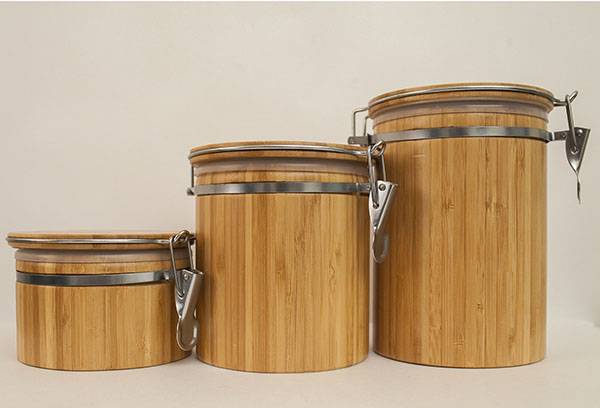
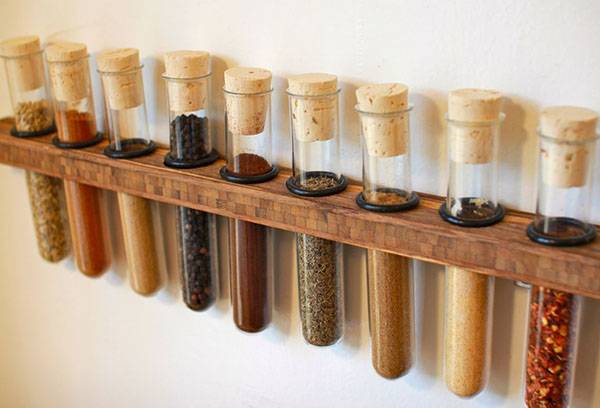
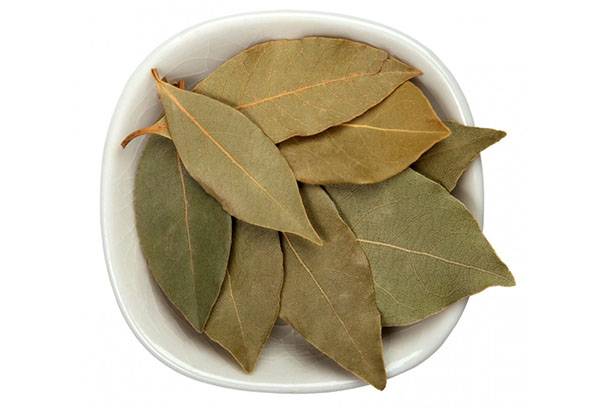
Thank you very much for the collection of tips, they were very useful. Many didn't know.
Useful article. Thank you .
Thank you very much, very useful article
Thank you, useful tips
Thank you!
Informative Brief Without unnecessary fluff Very useful information. Thank you.
Thank you, very useful article. I’m just moving, I’m shaking everything up and updating it.
Thank you, very useful
The information is very useful and interesting...thanks for the collection!
We bought wooden jars for storing cereals. Looks very beautiful. But there were bugs in the rice. Now I will buy glass or ceramic ones. It's a pity I didn't read the article earlier.